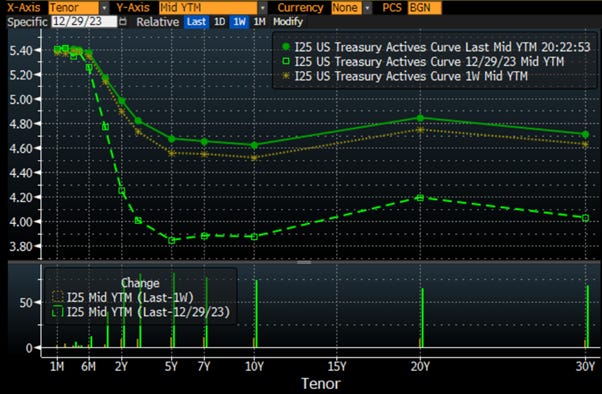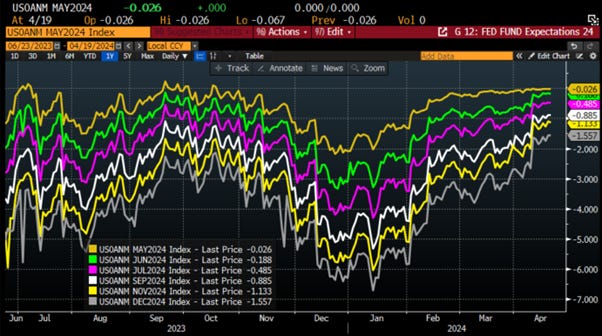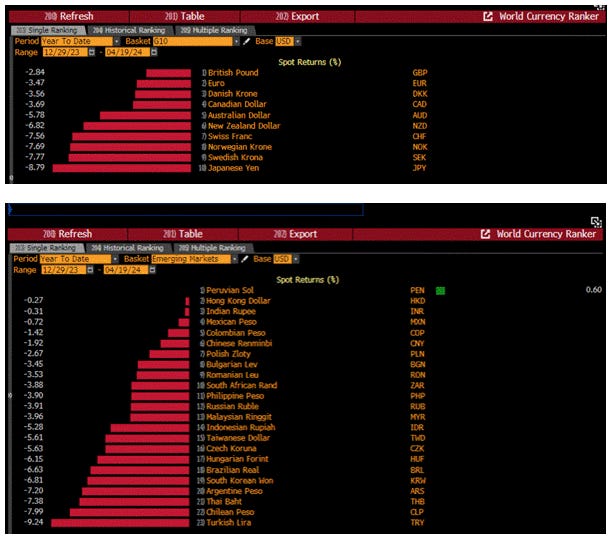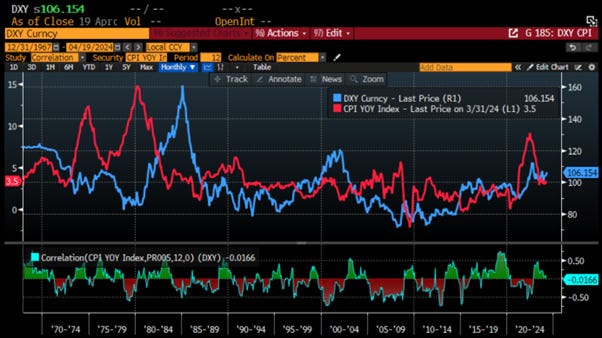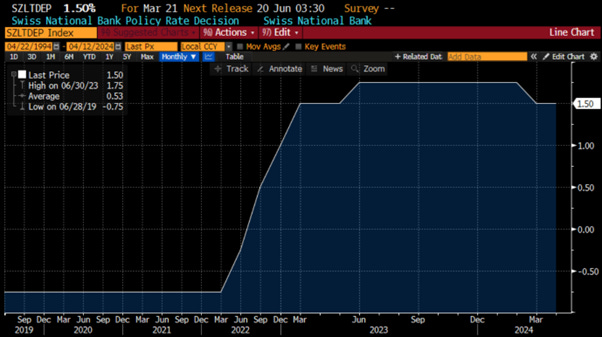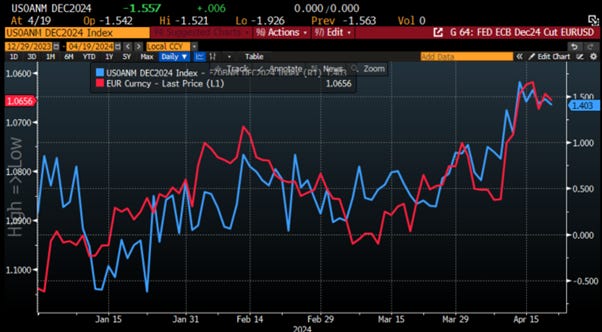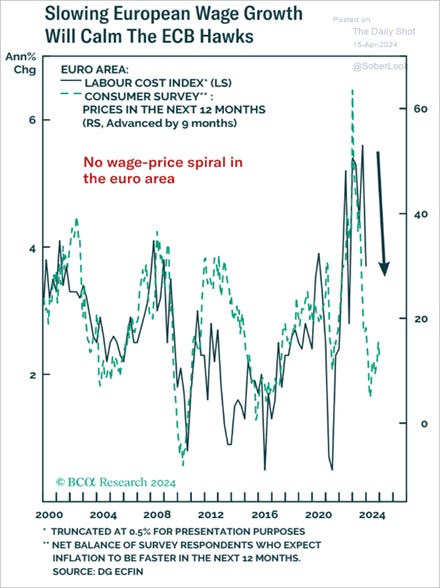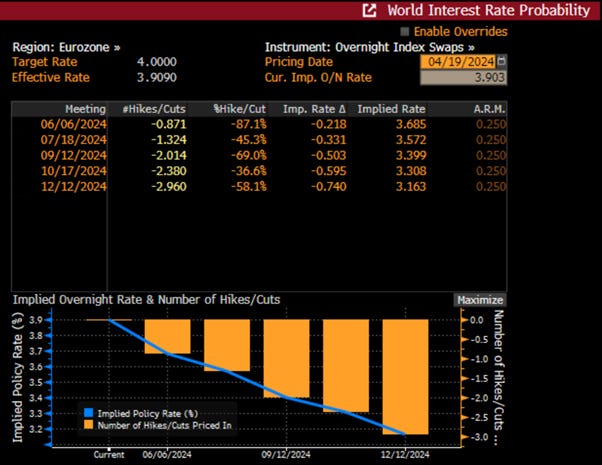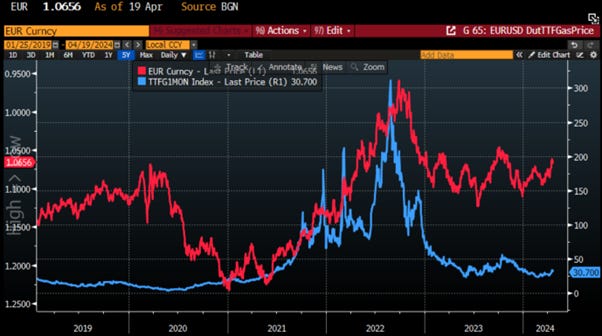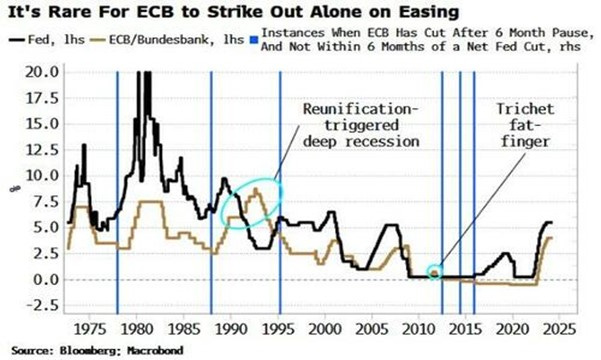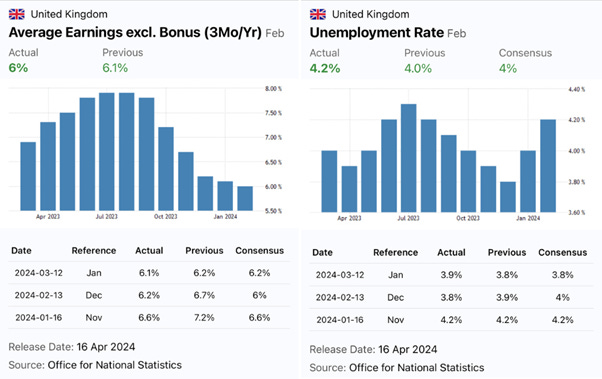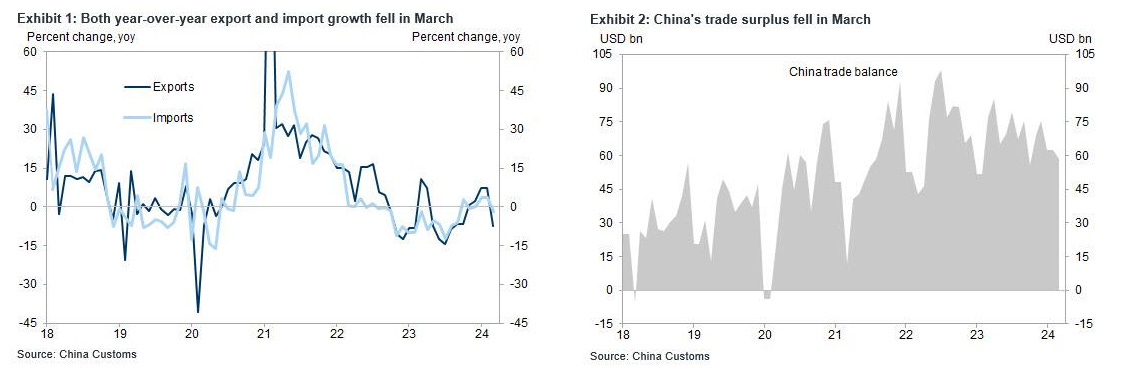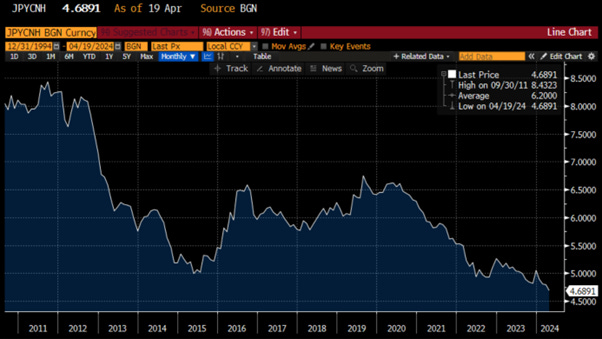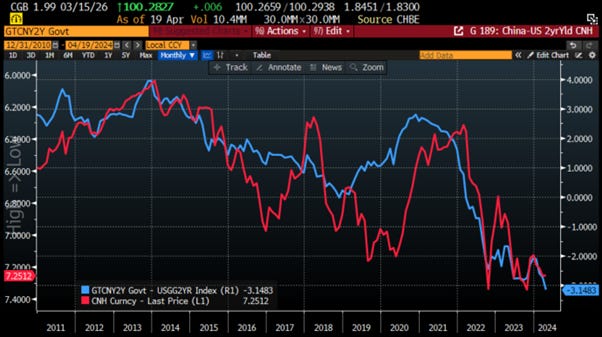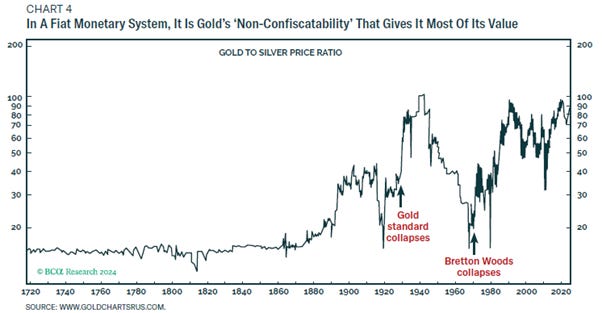The King $ Is Back!
While all eyes were blurred by the unfolding regional conflict in the Middle East, Jerome Powell used the opportunity of a speech at the Wilson Economic Forum to pivot, but not in the way that Wall Street YOLO investors had hoped for over the past 18 months. In his most direct comment about the FED’s expected path for rates after the inflation boomeranged, Powell admitted that ‘recent data show a lack of further progress on inflation.’ The bond market didn’t really like that pivot, as it pushed the bear steepening further out of its ‘Halloween hibernation’.
While anyone who understands English would have concluded that the FED will NOT cut rates this year, despite the additional comment from FED’s Williams who highlighted that ‘while rate-HIKES are not the baseline, they are possible if the data warrants’ , the ‘Forward Confusion’ driven myopic Wall Street consensus still discounts more than one interest rate cut for the year, with 88% probability of the first cut to happen now in September.
As mentioned previously, on March 18th, the USD index triggered a golden cross with the 50-day moving average crossing once again above the 200-day moving average. Examining the performance of the USD since the beginning of the year reveals a trend which has taken the widespread pessimism about the dollar at the outset of 2024 by surprise. Indeed, the USD has appreciated against ALL G10 fiat currencies and all except the Peruvian Sol among the EM currencies of the Bloomberg EM currency index.
At the start of the year, Wall Street was bearish on the Greenback due to the expectation that the FED would lead other central banks into an interest rate easing cycle. There was a belief that the world would short the USD and flock to other fiat currencies because the FED will pivot first. However, more than a quarter into the year, this narrative has been disrupted by the return of the inflation boomerang, which has thrown the concept of 'Forward Confusion' regarding easing US monetary policy into disarray.
USD Index (DXY Index); US CPI YoY Change & correlation.
Over the past 40 years, the USD's strengthening has typically coincided with higher 10-year yields and tighter financial conditions. With the FED likely feeling trapped by its 'Forward Confusion' narrative amid the resurgence of inflation and with the US election just seven months away, rather than having to abruptly change course on its narrative and lose faith, the FED could leverage the strengthening USD and rising 10-year yields to tighten financial conditions. This strategy could ultimately weaken the economy, thereby reducing the impact of inflation, which remains largely supply-driven.
Chicago FED US Financial Conditions Index (blue line); US 10-Year Yield (red line); USD Index (DXY index) (green line).
Outside the US, on March 22nd, the ‘venerable’ Swiss National Bank took the lead among G10 central banks and surprised financial markets by unexpectedly cutting interest rates by 25 basis points. The SNB's decision is significant not only because it marks Switzerland as the first major economy to lower rates since the Covid-19 pandemic, but also because it intensifies pressure on the European Central Bank (ECB) and the Bank of England (BOE) to take action sooner rather than later.
Not too long ago, the consensus pointed towards 'June' as ‘THE month’ for the FED and the ECB to ease monetary policy. However, in the last few weeks, the FED encountered obstacles as stronger-than-expected labour market data and persistent (services) CPI figures which tempered its intentions. It's now becoming evident that 'June' is no longer the pivotal month for the FED unless it is ready to let go inflation higher.
On the other side of the pond, in Europe, the European Central Bank provided strong hints at its April meeting that a cut in June is imminent. While persistent price pressures in services remain somewhat of a concern, this doesn't seem to hinder the likelihood of a first cut at the next policy meeting for Lagarde and her team. Indeed, the Council appears to have firmly decided that:
the data, reflecting a weak economy and disinflationary forces, have continued to move in the right direction, and
implementing a few cuts (starting with one) would still maintain policy restrictive enough to avoid derailing the disinflation process.
Spread between FED & ECB rate cuts as of December 2024 (blue line); EUR/USD Fx rate (axis inverted; red line).
Despite its mantra of 'data dependence' and inflation not yet reaching its target, the ECB Council seems convinced that a cut would be appropriate. The idea that ‘We will not wait for everything to be 2% before we cut’ encapsulates the ECB's current stance, suggesting a greater concern about making a policy error by easing too slowly despite sticky services inflation and labor market tightness. By emphasizing its data dependence and avoiding pre-commitment to any specific easing trajectory, the ECB likely believes it can manage the risk of an energy driven return of the inflation boomerang at an acceptable level as wage growth in the Euro area has been slowing and well below levels reached in the US.
A weakening of the Euro resulting from this divergence in monetary policy stances could however potentially lead to a slower easing cycle by the ECB at some point. However, it's worth noting that according to models, a significant drop in the euro would be needed before it has a material impact on inflation. As a rough estimate, a 1% drop in EUR/USD, associated with a 0.5% drop in the effective exchange rate, would lead to a modest increase in domestic inflation of around 0.05% in the first year and 0.15% after three years. Conversely, one could argue that higher US rates might spill over to Europe, dampening the effectiveness of ECB easing measures and potentially justifying a slightly faster cutting cycle by the ECB.
Overall, the ECB, which is even more politically driven than the FED, would likely aim to prevent the economy from weakening excessively leading up to the European Parliament election. Indeed, there is a high chance that Euro-sceptic parties may gain significant traction in the new parliament and potentially take the lead in some key countries later this year. Therefore, the ECB may be ‘politically motivated’ to take measures to support economic stability and confidence in the eurozone amidst these political shifts.
Spread between US & EUR Zone Economic Surprise (blue line); EUR/USD FX rate (axis inverted; red line).
Another headwind for the EUR is the rebound in energy prices, particularly natural gas prices. This increase has been influenced by the recent escalation of the conflict between Russia and Ukraine. Over the past weeks, there have been reports of the destruction of key gas storage facilities in Ukraine and refineries in Russia, exacerbating concerns about energy supply disruptions and contributing to upward pressure on natural gas prices.
Historically, there has been a negative correlation between the Dutch TTF Natural Gas forward price and the EUR/USD FX rate, as higher natural gas prices have been a leading indicator of rising economic challenges in Europe, which remains dependent on imports for its energy consumption.
Dutch TTF Natural Gas forward 1-month price (blue line); EUR/USD FX rate (axis inverted; red line).
While the prevailing outsider view now is that the ECB will not be cutting rates in June, it has been rare for Europe (i.e., the ECB and the Bundesbank pre-1999) to take the lead in pivoting into easing ahead of the FED. In fact, there have been only three occasions when the ECB has cut rates ahead of the FED in the modern era, and these were all during periods when Europe was in a negative-rate regime. The other three times when the then Bundesbank cut rates first were in the 1970s, after the 1987 crash, and during the recession caused by German reunification in the 1990s.
In the UK, March CPI slowed less than expected, with headline CPI at 3.2% YoY, driven partly by rising fuel prices. Despite having the worst inflation among the G7 post-Covid, the BOE is expected to pivot ahead of the FED, as the BOE will likely face a weaker economic environment and even more political pressures ahead of the incoming election. However, like the ECB, the BOE has been reluctant to jump the gun ahead of the FED on rate cuts, with only 3 instances over the past 50 years.
Outside the G10, weak domestic data in China, highlighted by this week's weak retail sales and industrial production, adds to the recent weak trade data in March. Chinese exports declined by 7.5% from a year earlier in March to $279.7 billion, falling far short of the median estimate of a 1.9% drop and sharply contrasting with the 7.1% growth in combined figures for January and February. This decline was attributed to a higher base in the same period last year, when China reported robust growth of 14.8% at $315.6 billion. Imports also slumped, sliding by 1.9% year-on-year in March, well below the Bloomberg consensus of a 1.0% increase. With exports collapsing, China's trade balance also slumped, dropping to just $58.6 billion in March, significantly worse than the Bloomberg consensus of $69.1 billion, and down from the January-February average balance of US$62.6 billion. Today's release of trade data only covers major trading partners and products.
In 2023, China saw its first decline in export growth in 7 years, dropping by 4.6% due to weak external demand. This posed additional challenges for Beijing's efforts to revive the post-pandemic economy, alongside an exodus of foreign investment, waning market confidence, and potential trade barriers. The disappointing trade numbers exacerbated concerns for the world's second-largest economy, impacting the yuan's retreat, which aligns with China's desire for a weaker currency to boost exports. However, achieving this goal is proving difficult, with the yen falling to record lows against the yuan and breaching key support levels.
On the other hand, the dollar-yuan movement reflects diverging central bank policies. Without official yen support or a shift in FED rate cut expectations, Chinese authorities have limited options against a strengthening USD, especially with the PBOC expected to ease monetary policy. Despite attempts to defend the yuan and avoid capital outflows, China may ultimately resort to devaluing the currency. While Beijing has signalled commitment to yuan stability, a sudden 10% devaluation could occur anytime as it will probably help the economy by boosting exports. However, China faces a dilemma: maintain currency stability and lose out to a weakening yen, or devalue the yuan to boost exports, risking significant capital outflows.
Spread between China & US 2-Year Yield (blue line); CNH/USD FX Rate (axis inverted; red line)
On a side note, while the Chinese economy has been apparently weak since the start of the Covid pandemic, not only did China's crude oil imports hit a record high in 2023, breaking the previous record from 2020, but China is also building up copper reserves. The most obvious reason could not be that China is stockpiling ahead of a possible extension of geopolitical tension in Asia, but most likely that China is looking to flood the world, particularly Europe, with subsidized ‘magical mirrors’ (i.e., solar panels), ‘windmills’ (i.e., wind turbines), and EVs.
The only currency, apart from the Peruvian sol which may have benefited from the rise in copper prices, that has appreciated against the USD this year is Gold. Gold's appreciation is attributed to its status as a hedge against government risks, primarily due to its ‘non-confiscatability’, which constitutes a significant portion of its value.
Throughout history, governments have confiscated investors' wealth through three main methods:
Monetary inflation, which stealthily erodes the real value of wealth over time.
Allowing the failure of banks and other financial institutions that hold investors' wealth.
The outright expropriation of wealth, as seen in historical events like the confiscation of properties in Europe in the 1930s.
Gold is ‘non-confiscatable’ in two of these scenarios:
Gold cannot be confiscated through inflation due to its controlled supply.
Gold cannot be confiscated through bank failure.
In a fiat monetary system, it is this ‘non-confiscatability’ of gold and because it is a hedge against government risk that largely contributes to its value.
Much of Gold's value cannot be confiscated because it derives from its physical properties. These include its inertness, which makes it highly coveted for jewellery that remains beautiful indefinitely, as well as its high electrical and thermal conductivity. However, other precious metals in Gold's vicinity on the periodic table, such as silver, platinum, and palladium, can substitute for gold's physical properties. Therefore, we can quantify the portion of gold's value that originates from its physical properties by considering its relative scarcity compared to silver (as indicated by the 'mining ratio') multiplied by the price of silver.
For centuries, the price of Gold primarily tracked its scarcity relative to silver multiplied by the price of silver. However, when the world transitioned to a fiat monetary system, first in 1931 after the collapse of the gold standard and again in 1971 after the collapse of the Bretton Woods 'pseudo gold standard', the price of gold surged well above its scarcity relative to silver. This serves as compelling evidence that in a fiat monetary system, the dominant portion of gold's value arises from its non-confiscatability by banks or government’s failure.
Read more and discover how to position your portfolio here: https://themacrobutler.substack.com/p/the-king-is-back
At The Macro Butler, our mission is to leverage our macro views to provide actionable and investable recommendations to all types of investors. In this regard, we offer two types of portfolios to our paid clients.
The Macro Butler Long/Short Portfolio is a dynamic and trading portfolio designed to invest in individual securities, aligning with our strategic and tactical investment recommendations.
The Macro Butler Strategic Portfolio consists of 20 ETFs (long only) and serves as the foundation for a multi-asset portfolio that reflects our long-term macro views.
Investors interested in obtaining more information about the Macro Butler Long/Short and Strategic portfolios can contact us at info@themacrobutler.com.
Unlock Your Financial Success with the Macro Butler!
Disclaimer
The content provided in this newsletter is for general information purposes only. No information, materials, services, and other content provided in this post constitute solicitation, recommendation, endorsement or any financial, investment, or other advice.
Seek independent professional consultation in the form of legal, financial, and fiscal advice before making any investment decisions.
Always perform your own due diligence.


